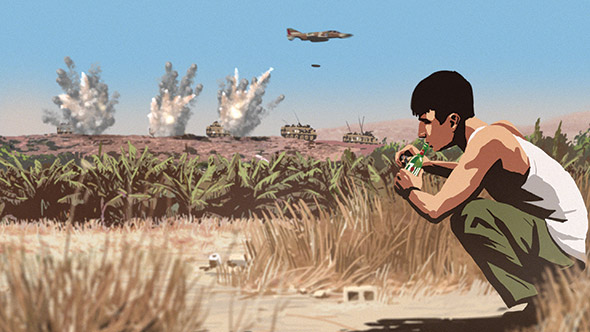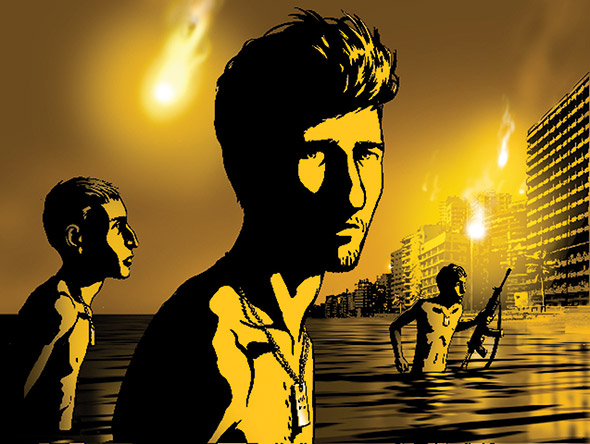
Text by Jesi Khadivi
Waltz With Bashir impressively navigates the cross-currents of anguish, fantasy and war, all the while reminding us through the veil of post-traumatic reverie that war’s vagaries are very, very real.
In the summer of 1982, Israeli soldiers invaded Southern Lebanon with the intent of “stabilizing” the civil war-torn country that was being used as a launch pad for rocket attacks. As Israeli forces waited to enter the Lebanese capital, Beirut, a treaty was signed between Israel and Palestinians, stating that if PLO combatants were sent by ship to Tunisia, Israel would lift the siege on Beirut. In the midst of this delicate ceasefire, Lebanese president elect (and Ariel Sharon favorite), Bashir Gemayel, was assassinated while giving a speech in East Beirut. In an orgy of retaliatory violence, gunmen from Gemayel’s Phalangist party stormed the refugee camps of West Beirut to avenge the death of their beloved leader. As is all too often the case with blood debts, the victims of the brutal massacre in the refugee camps of Sabra and Shatila were exclusively civilians, many of them children and elderly.
Fast-forward 25 years to two former soldiers sitting in a bar. Ari Folman, a documentary filmmaker, has been summoned by his friend, Boaz Rein Buskila. Visions of war have crept into the soulful accountant’s dreams. But Buskila isn’t plagued by apparitions of fallen soldiers or shell-pocked battlefields. Rather, twenty-six dogs have been chasing him ever since he left occupied territory, and they’ve finally tracked him down at his office. Because he had difficulty killing people, Buskila had been assigned to shoot barking dogs. And he remembered each and every one he shot.
Unlike Buskila, Folman remembers nothing. But after leaving his friend, a solitary recollection of wartime comes flooding back to him in a dream. Three soldiers awaken in the ocean, illuminated by flares from above. As they head into the devastated streets of Beirut, grief stricken Palestinian survivors of the Sabra and Shatila massacres swarm around them in a hallucinatory procession.
Folman’s encounter with Buskila and the sole memory it elicits provided the impetus for his feature length animated documentary, Waltz With Bashir. Waltz follows Folman as he attempts to unravel Israel’s role in the Sabra and Shatila massacres, and by extension his own involvement. He interviews old war buddies, acclaimed war correspondent Ron Ben-Yishai, and a psychologist in his quest to locate and understand his missing memories. Untraditional as it may seem, Folman felt that animation was the only way to tell his story. And he’s right. In many ways, Waltz is a story without images. At least photographic images. According to Folman, very little decent archival footage of the first Lebanese War exists, and even if it did, newsreel footage and army generals couldn’t begin to tell Folman’s story. With its focus on the spaces between memory, forgetting is a vital aspect of Waltz’s story, as is the dynamic nature of memory itself. At least three different animation styles and color palettes are used to evoke its ambiguity.

Waltz With Bashir is Folman’s third feature film and his second animated work. He experimented with the form in the animated introductory sequences for The Material that Love is Made Of, a documentary series made for Israeli television about the substance of love, based on American chemist Helen Fisher’s discovery that love is actually hormonal matter. Though the bold visual style that Folman honed in Waltz With Bashir is evident in its germinal stages in Material, his early animation cleverly riffs on animated educational shorts, while Waltz mines the medium’s capacity for pathos—which is heightened by experimental composer, Max Richter’s, original score. Although Waltz’s casual format of folks sitting around talking about issues like dreams, repression and memory have prompted many to draw comparisons to Richard Linklater’s animated jaw-fest, Waking Life, Waltz was drawn using a mixture of Flash, 3D and traditional animation techniques, rather than the rotoscoping used for Waking Life and A Scanner Darkly. A favorite at the Cannes and New York Film Festivals, the film won the Golden Globe award for Best Foreign Language Film and is an official Academy Award entry for Best Animated Feature and Best Foreign Language Film.
Folman does not wield the documentary form as a pedagogical tool, nor does he create a comprehensive contextual framework for the viewer to understand Israel’s invasion of Lebanon. He shuns traditional documentary’s fixation on experts and verisimilitude, which can desensitize viewers. By positing war at a dreamlike distance, Folman brings its atrocity closer. “War is so surreal,” Folman says, “and memory is so tricky that I thought I had better take the journey with the help of very fine illustrators.”
The personal is political in Waltz With Bashir; in focusing on the non-linear and oft-fantastical stories of fellow Israeli soldiers, Folman resists using documentary in the service of history, instead delving into the highly subjective and fragmentary testimonials of his peers. Waltz With Bashir impressively navigates the cross-currents of anguish, fantasy and war, all the while reminding us through the veil of post-traumatic reverie that war’s vagaries are very, very real.

